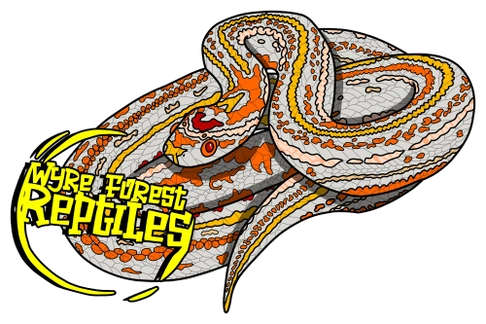Royal Python Care
Python Regius
Native Country: Central Africa
Adult size: 4-5ft
Longevity: 20-30 years
Housing
We have found that they do best when kept in rack systems in suitably sized tubs, this helps to reduce any feeding problems that can sometimes occur. We like to start babies off in 3L Braplast tubs, moving on to V18 tubs, then onto V35 and finally V70 tubs as they grow. We actually keep most of ours in Alurack systems. If you want to keep your snake in a vivarium, we would recommend using smaller tubs whilst it grows and then moving it into a vivarium when it is bigger and feeding well. An adult would do well in a 4ft vivarium.
We like to keep housing for them simple; they have a hide boxes and a water bowl. If kept in a vivarium you would need to add more hides and décor so the snake does not feel exposed.
Substrate
So what substrate should you use on the bottom of your vivarium / tub? You have several choices, these are listed below, along with any advantages and disadvantages of each one.
Reptiblock / Herp Husk
Allows the snakes to dig and bury in which helps make them feel more secure. It absorbs any waste and is also easy to spot clean.
Unprinted newspaper
Cheap and easy to replace option. They still allow the snakes to bury if you give them several layers.
Heating
Royal Python’s are cold blooded like all reptiles and need to be provided with the correct temperatures within their caging to allow them to thrive. An ambient temperature of around 80°f (26.5°c) is perfect, with a hot basking spot of 88-92°f (31-33.5°c). They do not seem to tolerate lower temperatures and can become prone to respiratory infections, so make sure the ambient temperature is always high enough.
Heatmat: A heatmat is the easiest way to provide your snake with a warm end when kept in a tub, you should use a heatmat which covers about 1/3 of your tub floor space, and place it right at one end. When using a wooden vivarium we would recommend the use of alternative heating described below. When using a heatmat, you can use a pulse thermostats to control it, we can recommend Habistat or InkBird thermostats. Make sure your thermostat probe is placed on top of your heatmat, this will allow you to accurately control how warm your warm end gets. You now need a digital thermometer (with a probe, or an infra red gun) to measure how warm it is getting and adjust the thermostat as needed. Please do not use the analogue thermometers as they are not accurate.
Heat lamp
You may use a heat lamp (or ceramic heater) to provide your basking spot if using a vivarium. You again need to set this up at one end of the vivarium and set it up just like you did a heat mat. The only difference is that you need to use a dimming thermostat. This type of thermostat dims down the bulb to create the correct temperature, a normal thermostat would turn it on and off, creating a disco and shortening the life of your bulb! Pulse stats are ok to use with ceramic heaters as they do not produce light. Depending on the size of your vivarium and how warm the room you are housing them in is, you may have to try different wattage bulbs to find one which works best, however 40W / 60W is normally ok. Remember to check your temperatures carefully with a digital thermometer though. Make sure any bulbs are guarded to prevent burns.
We also like to give their cage a quick spray with water every day to keep the humidity up.
Lighting
Being nocturnal they do not need UV lighting, although a good day / night cycle is provided.
Feeding
Young royals can be started on defrosted rat pups and they will soon move up the sizes as they grow. We like to feed every 5 days or so for young animals, cutting back to once a week as they reach around a year old. Sometimes they can refuse to eat and will require some tips and tricks to get them going. First of all, make sure your housing is spot on and the snake feels secure. If the snake is new it may not eat for several weeks as it settles in to its new surroundings. After this time you can try some of these tips: braining the rat, heating the prey with a hairdryer so it’s really hot, different prey, fresh killed prey. They normally eat eventually if you’re keeping them correctly so just keep trying. If all fails, contact us or a vet.
Sexing
They can be sexed by popping or probing. We will pop young animals but always probe anything that is older. Males will probe much deeper and when popped their hemipenes will show. Females will show nothing when popped and only probe to a shallow depth. Never try to pop or probe a snake unless you have been shown how to do it as you can injure the snake.
